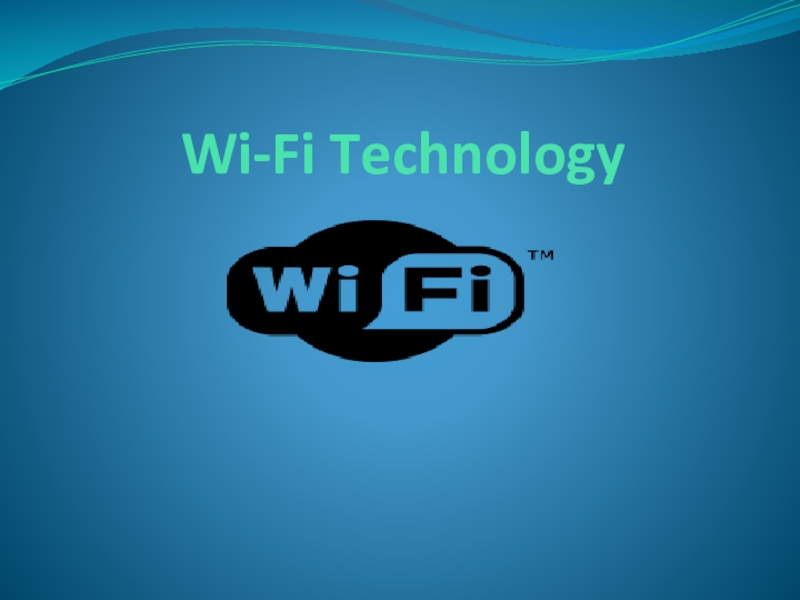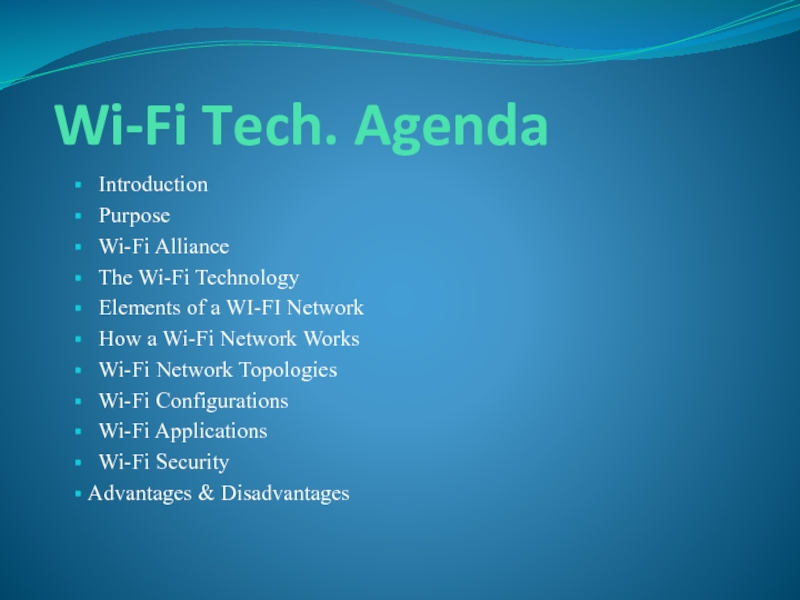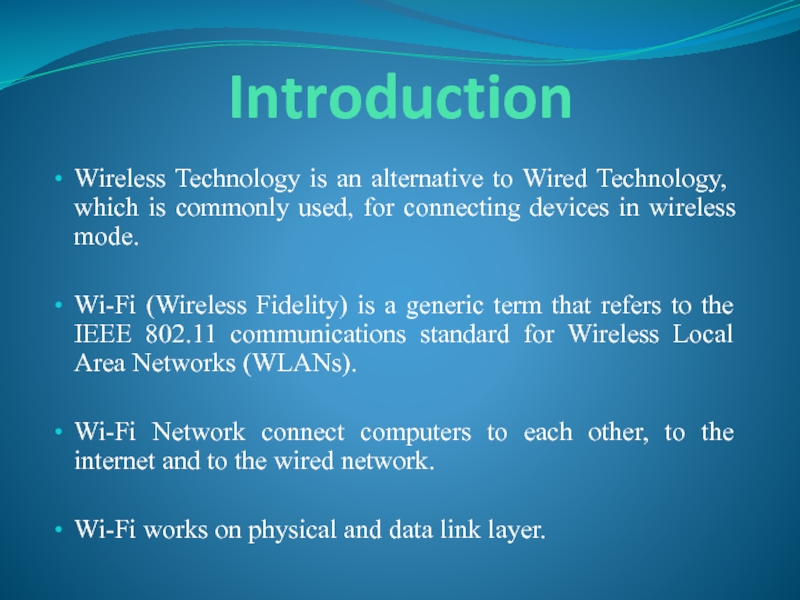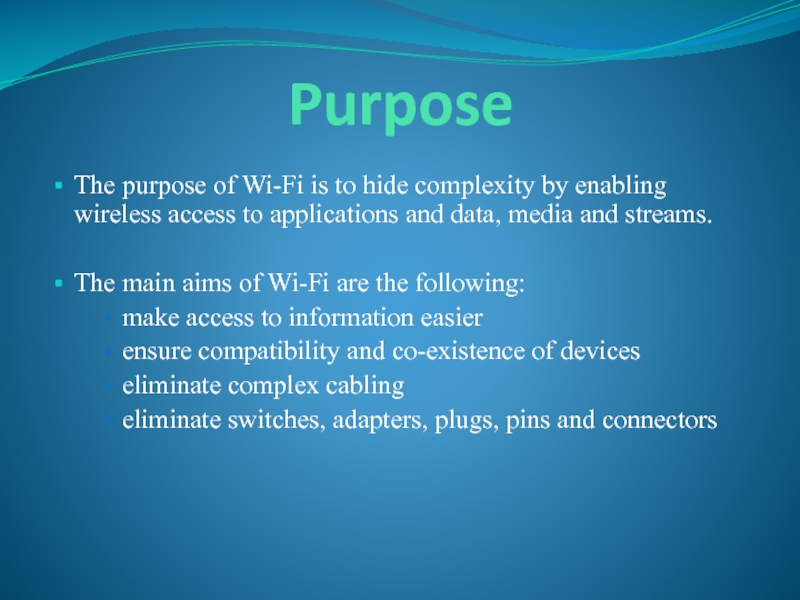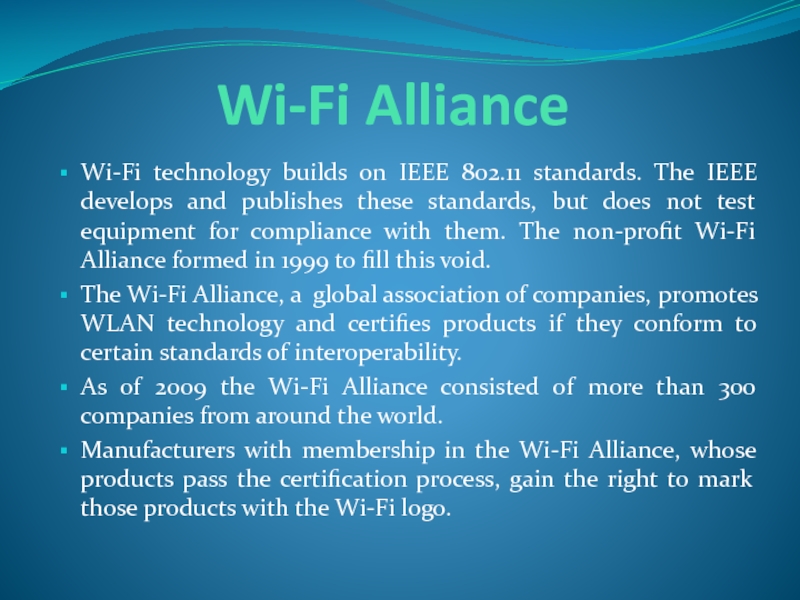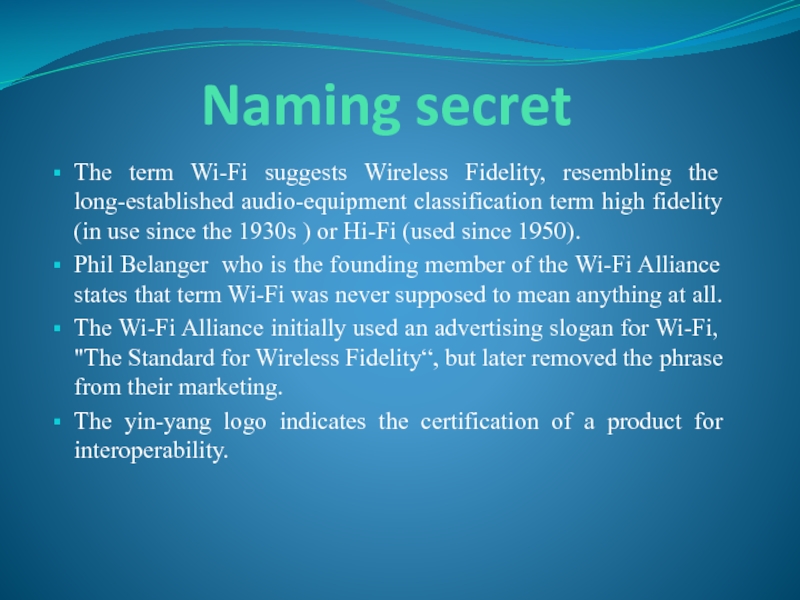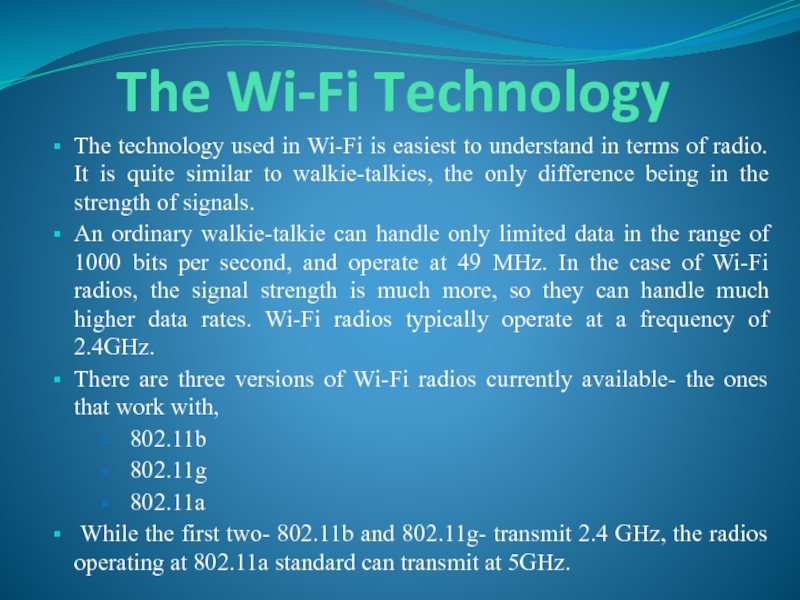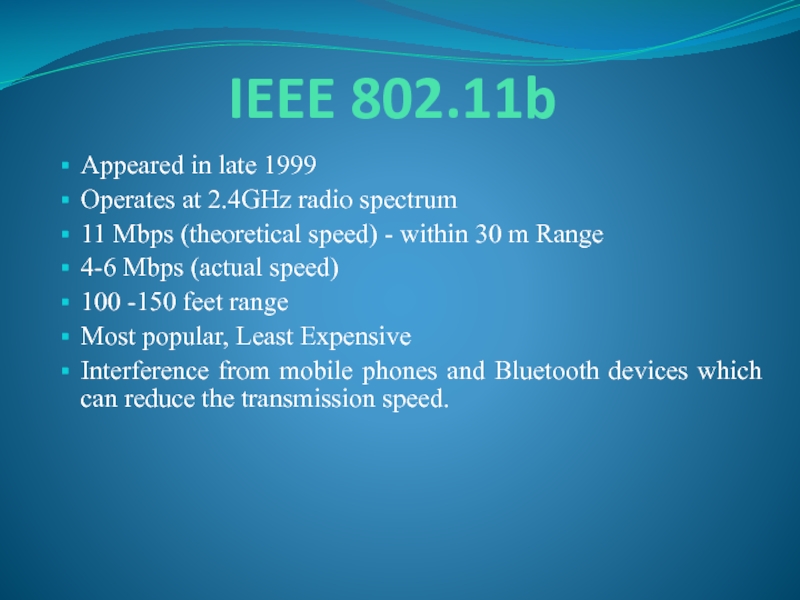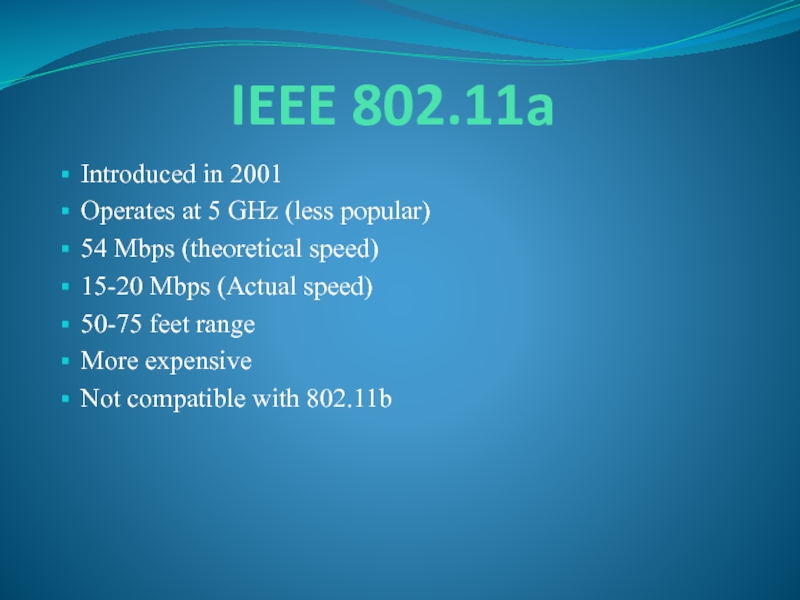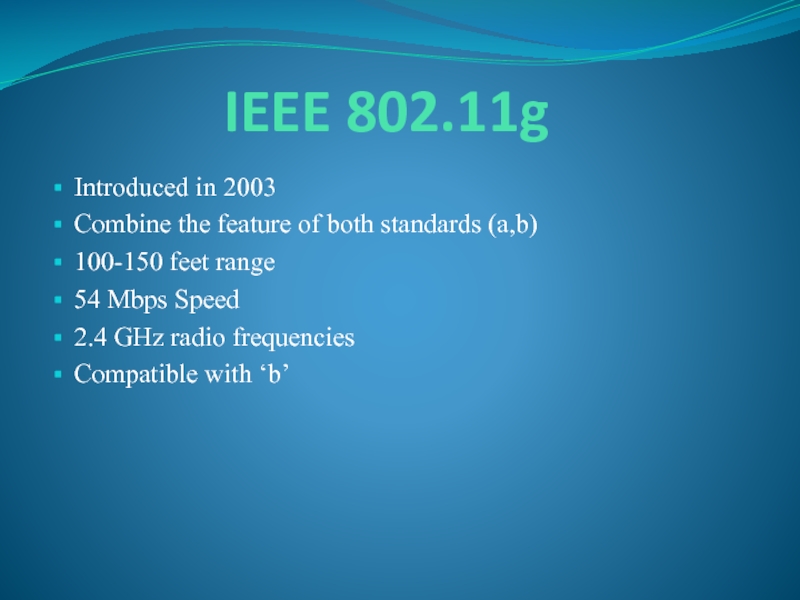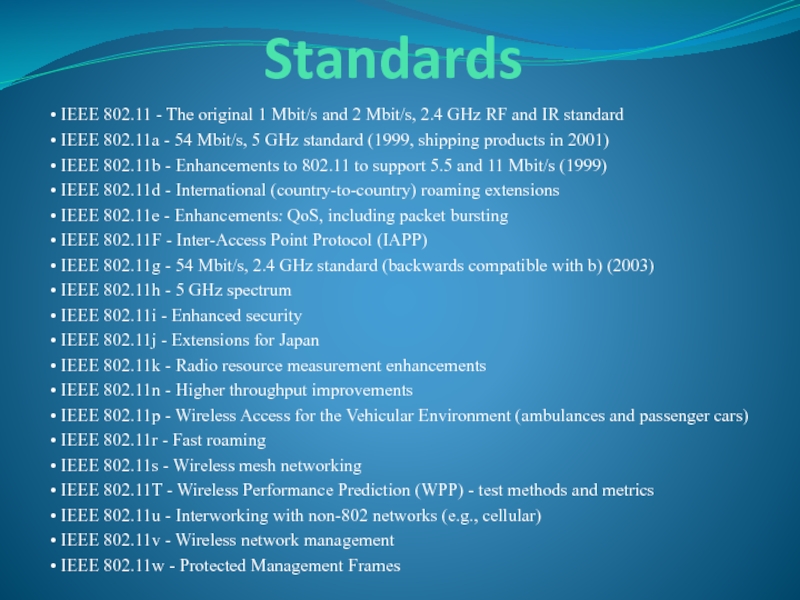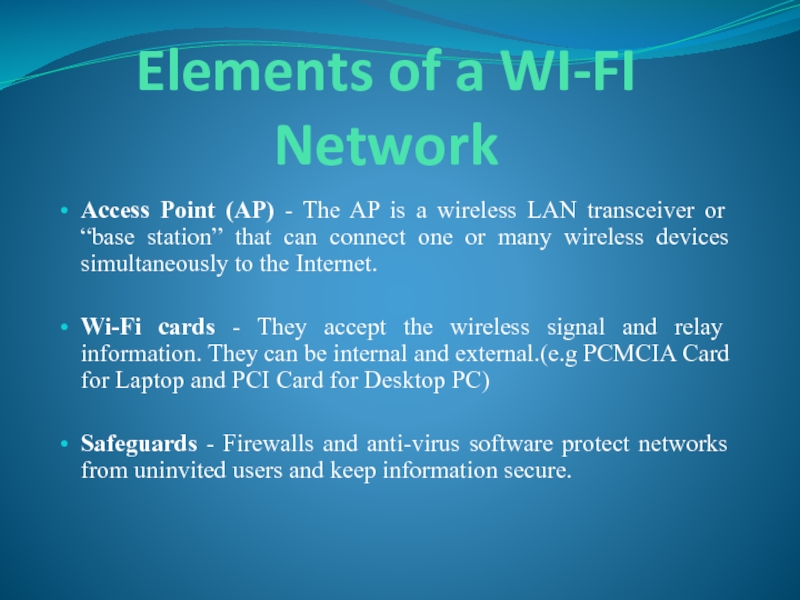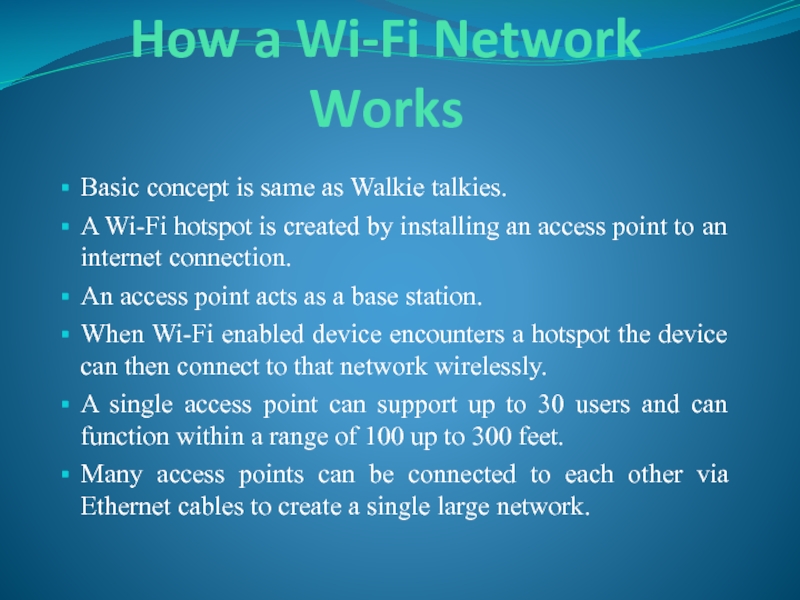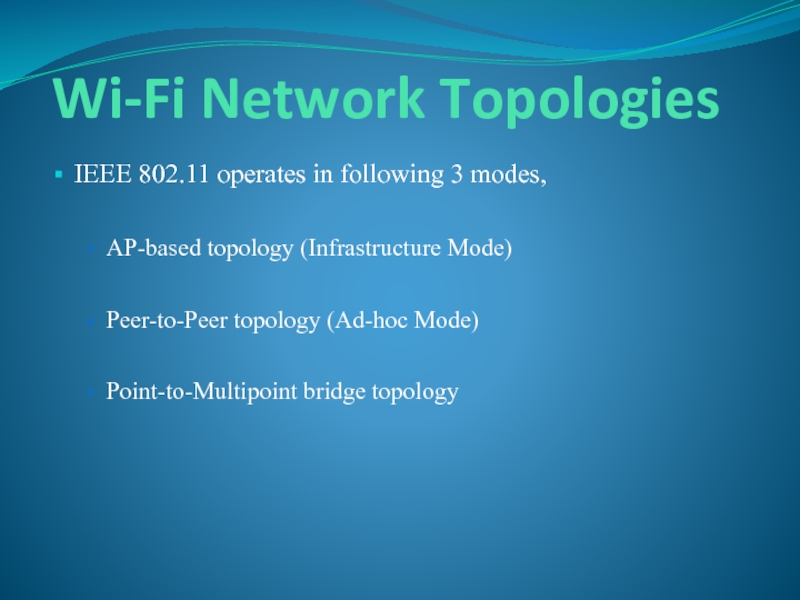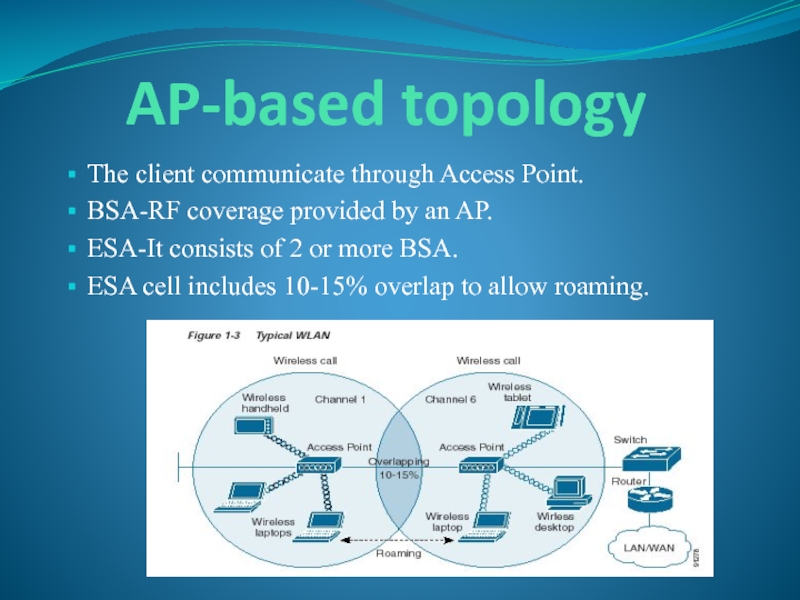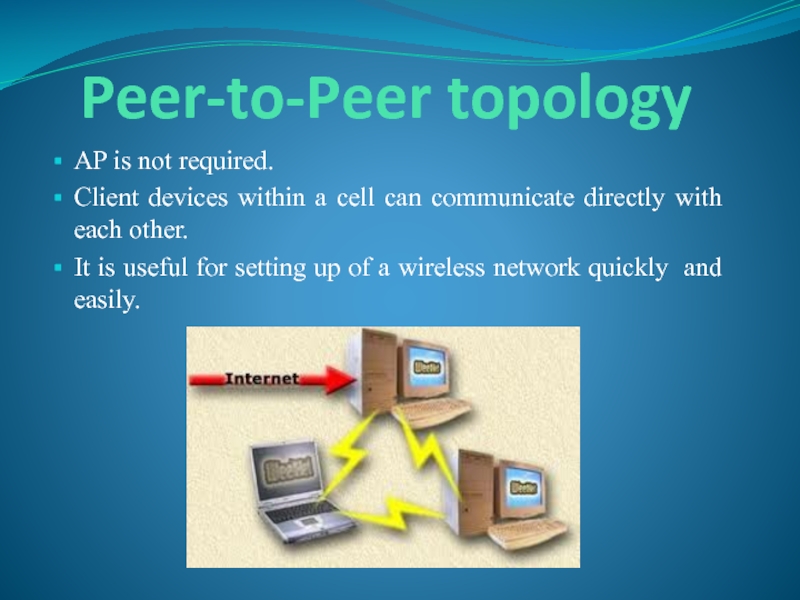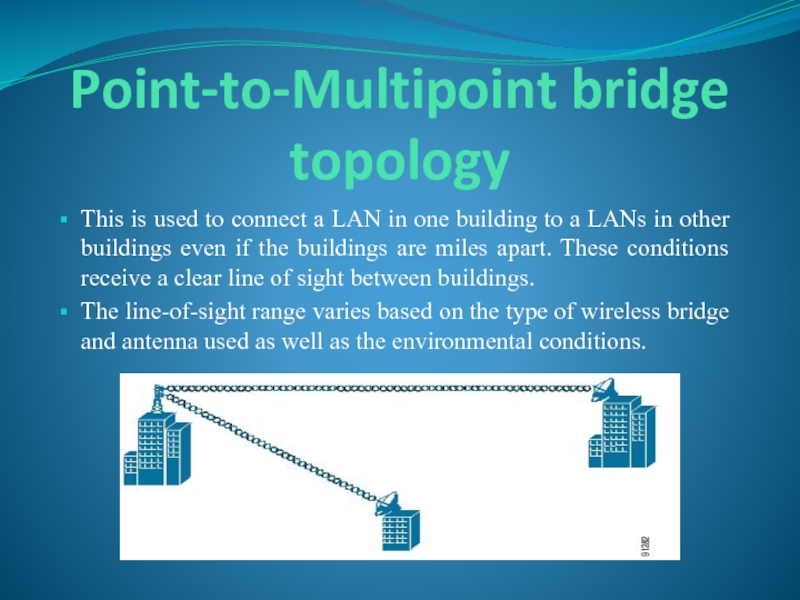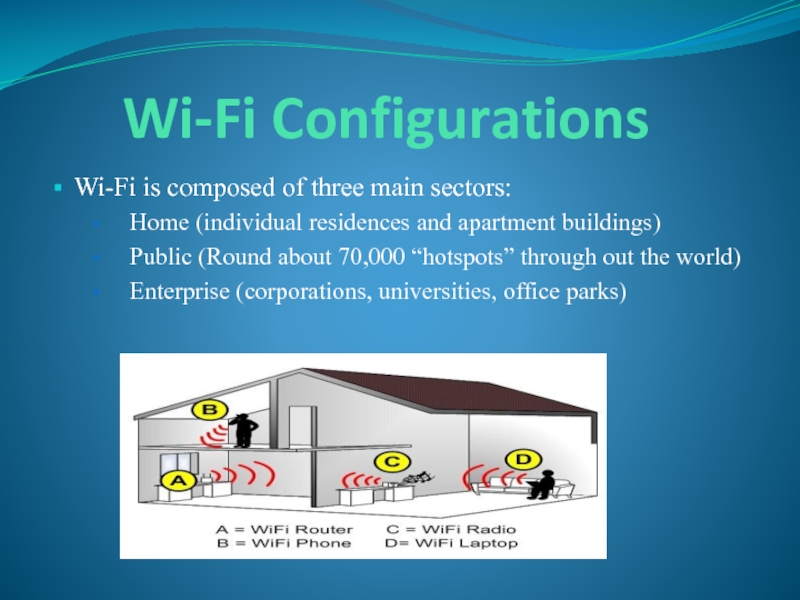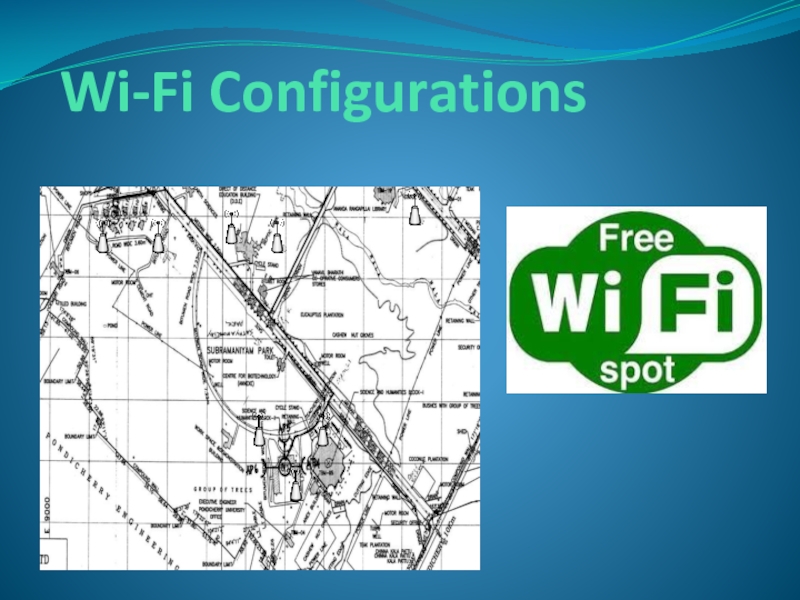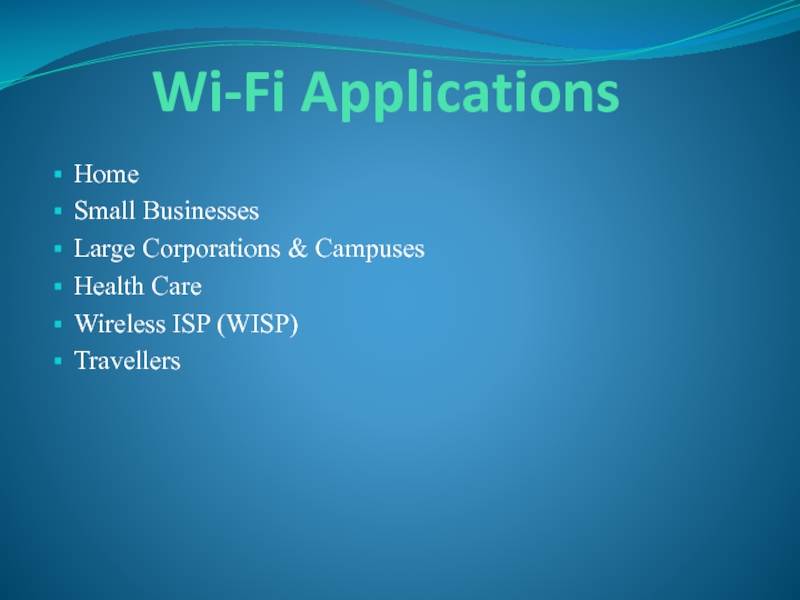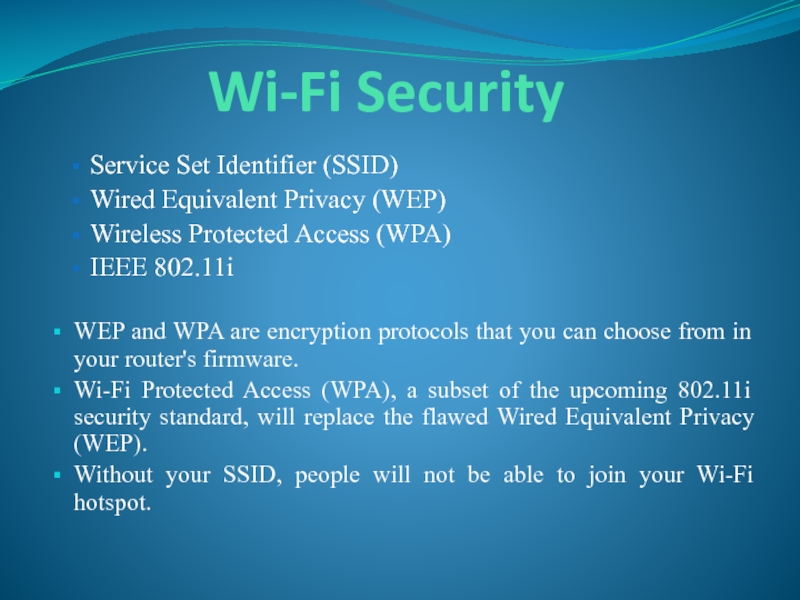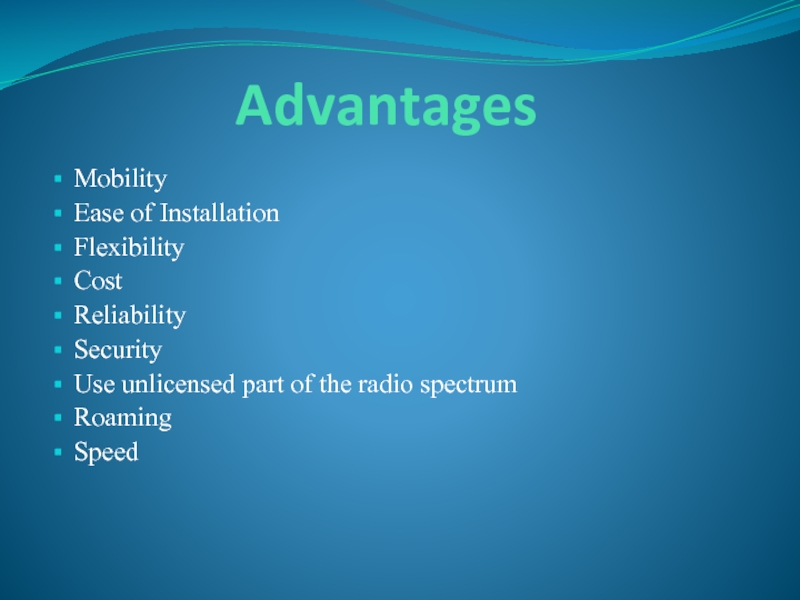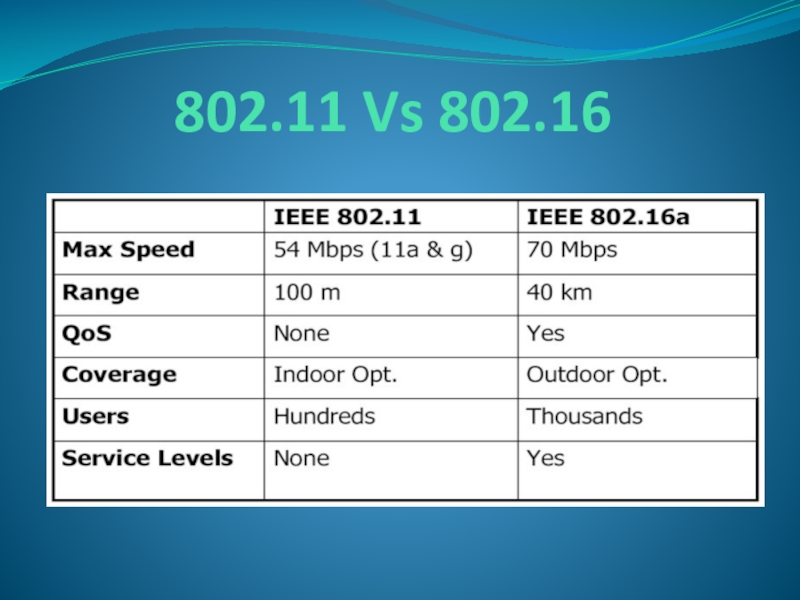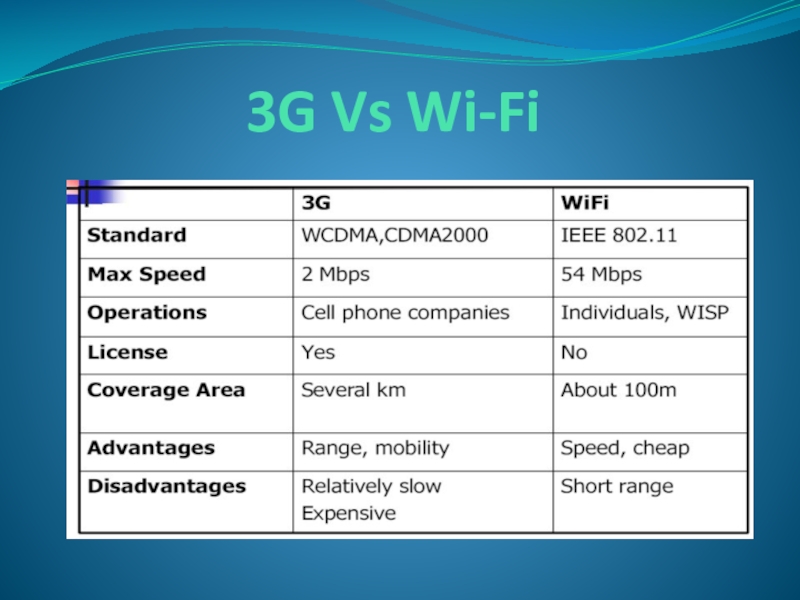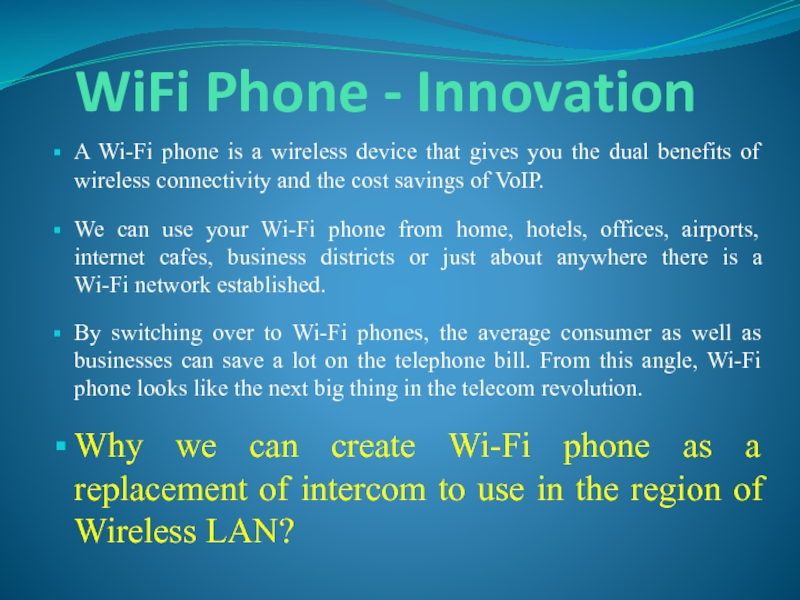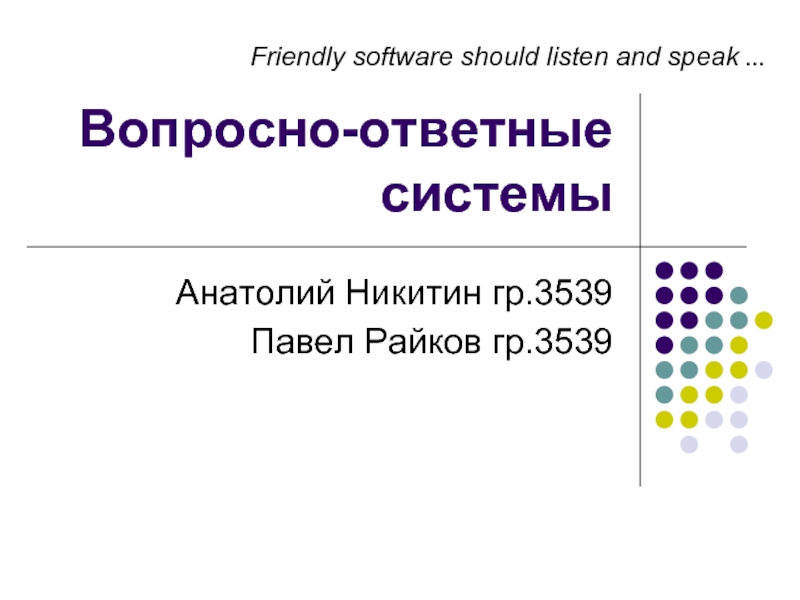- Главная
- Разное
- Дизайн
- Бизнес и предпринимательство
- Аналитика
- Образование
- Развлечения
- Красота и здоровье
- Финансы
- Государство
- Путешествия
- Спорт
- Недвижимость
- Армия
- Графика
- Культурология
- Еда и кулинария
- Лингвистика
- Английский язык
- Астрономия
- Алгебра
- Биология
- География
- Детские презентации
- Информатика
- История
- Литература
- Маркетинг
- Математика
- Медицина
- Менеджмент
- Музыка
- МХК
- Немецкий язык
- ОБЖ
- Обществознание
- Окружающий мир
- Педагогика
- Русский язык
- Технология
- Физика
- Философия
- Химия
- Шаблоны, картинки для презентаций
- Экология
- Экономика
- Юриспруденция
Wi-Fi Technology презентация
Содержание
- 1. Wi-Fi Technology
- 2. By. P. Victer Paul
- 3. Wi-Fi Tech. Agenda Introduction Purpose
- 4. Introduction Wireless Technology is an alternative
- 5. Purpose The purpose of Wi-Fi is
- 6. Wi-Fi Alliance Wi-Fi technology builds on
- 7. Naming secret The term Wi-Fi suggests Wireless
- 8. The Wi-Fi Technology The technology used in
- 9. IEEE 802.11b Appeared in late 1999 Operates
- 10. IEEE 802.11a Introduced in 2001 Operates at
- 11. IEEE 802.11g Introduced in 2003 Combine the
- 12. Standards • IEEE 802.11 - The original
- 13. Elements of a WI-FI Network Access Point
- 14. How a Wi-Fi Network Works Basic concept
- 15. Wi-Fi Network Topologies IEEE 802.11 operates in
- 16. AP-based topology The client communicate through Access
- 17. Peer-to-Peer topology AP is not required. Client
- 18. Point-to-Multipoint bridge topology This is used to
- 19. Wi-Fi Configurations Wi-Fi is composed of three
- 20. Wi-Fi Configurations
- 21. Wi-Fi Applications Home Small Businesses Large Corporations
- 22. Wi-Fi Security Service Set Identifier (SSID)
- 23. Advantages Mobility Ease of Installation Flexibility Cost
- 24. Limitations Interference Degradation in performance High power consumption Limited range
- 25. 802.11 Vs 802.16
- 26. 3G Vs Wi-Fi
- 27. WiFi Phone - Innovation A Wi-Fi phone
- 28. Thank You
Слайд 2By.
P. Victer Paul
Dear,
We planned to share our eBooks
and project/seminar contents for free to all needed friends like u.. To get to know about more free computerscience ebooks and technology advancements in computer science. Please visit....
http://free-computerscience-ebooks.blogspot.com/
http://recent-computer-technology.blogspot.com/
http://computertechnologiesebooks.blogspot.com/
Please to keep provide many eBooks and technology news for FREE. Encourage us by Clicking on the advertisement in these Blog.
http://free-computerscience-ebooks.blogspot.com/
http://recent-computer-technology.blogspot.com/
http://computertechnologiesebooks.blogspot.com/
Please to keep provide many eBooks and technology news for FREE. Encourage us by Clicking on the advertisement in these Blog.
Слайд 3Wi-Fi Tech. Agenda
Introduction
Purpose
Wi-Fi Alliance
The Wi-Fi Technology
Elements
of a WI-FI Network
How a Wi-Fi Network Works
Wi-Fi Network Topologies
Wi-Fi Configurations
Wi-Fi Applications
Wi-Fi Security
Advantages & Disadvantages
How a Wi-Fi Network Works
Wi-Fi Network Topologies
Wi-Fi Configurations
Wi-Fi Applications
Wi-Fi Security
Advantages & Disadvantages
Слайд 4 Introduction
Wireless Technology is an alternative to Wired Technology, which is
commonly used, for connecting devices in wireless mode.
Wi-Fi (Wireless Fidelity) is a generic term that refers to the IEEE 802.11 communications standard for Wireless Local Area Networks (WLANs).
Wi-Fi Network connect computers to each other, to the internet and to the wired network.
Wi-Fi works on physical and data link layer.
Wi-Fi (Wireless Fidelity) is a generic term that refers to the IEEE 802.11 communications standard for Wireless Local Area Networks (WLANs).
Wi-Fi Network connect computers to each other, to the internet and to the wired network.
Wi-Fi works on physical and data link layer.
Слайд 5 Purpose
The purpose of Wi-Fi is to hide complexity by enabling
wireless access to applications and data, media and streams.
The main aims of Wi-Fi are the following:
make access to information easier
ensure compatibility and co-existence of devices
eliminate complex cabling
eliminate switches, adapters, plugs, pins and connectors
The main aims of Wi-Fi are the following:
make access to information easier
ensure compatibility and co-existence of devices
eliminate complex cabling
eliminate switches, adapters, plugs, pins and connectors
Слайд 6Wi-Fi Alliance
Wi-Fi technology builds on IEEE 802.11 standards. The IEEE
develops and publishes these standards, but does not test equipment for compliance with them. The non-profit Wi-Fi Alliance formed in 1999 to fill this void.
The Wi-Fi Alliance, a global association of companies, promotes WLAN technology and certifies products if they conform to certain standards of interoperability.
As of 2009 the Wi-Fi Alliance consisted of more than 300 companies from around the world.
Manufacturers with membership in the Wi-Fi Alliance, whose products pass the certification process, gain the right to mark those products with the Wi-Fi logo.
The Wi-Fi Alliance, a global association of companies, promotes WLAN technology and certifies products if they conform to certain standards of interoperability.
As of 2009 the Wi-Fi Alliance consisted of more than 300 companies from around the world.
Manufacturers with membership in the Wi-Fi Alliance, whose products pass the certification process, gain the right to mark those products with the Wi-Fi logo.
Слайд 7Naming secret
The term Wi-Fi suggests Wireless Fidelity, resembling the long-established audio-equipment
classification term high fidelity (in use since the 1930s ) or Hi-Fi (used since 1950).
Phil Belanger who is the founding member of the Wi-Fi Alliance states that term Wi-Fi was never supposed to mean anything at all.
The Wi-Fi Alliance initially used an advertising slogan for Wi-Fi, "The Standard for Wireless Fidelity“, but later removed the phrase from their marketing.
The yin-yang logo indicates the certification of a product for interoperability.
Phil Belanger who is the founding member of the Wi-Fi Alliance states that term Wi-Fi was never supposed to mean anything at all.
The Wi-Fi Alliance initially used an advertising slogan for Wi-Fi, "The Standard for Wireless Fidelity“, but later removed the phrase from their marketing.
The yin-yang logo indicates the certification of a product for interoperability.
Слайд 8The Wi-Fi Technology
The technology used in Wi-Fi is easiest to understand
in terms of radio. It is quite similar to walkie-talkies, the only difference being in the strength of signals.
An ordinary walkie-talkie can handle only limited data in the range of 1000 bits per second, and operate at 49 MHz. In the case of Wi-Fi radios, the signal strength is much more, so they can handle much higher data rates. Wi-Fi radios typically operate at a frequency of 2.4GHz.
There are three versions of Wi-Fi radios currently available- the ones that work with,
802.11b
802.11g
802.11a
While the first two- 802.11b and 802.11g- transmit 2.4 GHz, the radios operating at 802.11a standard can transmit at 5GHz.
An ordinary walkie-talkie can handle only limited data in the range of 1000 bits per second, and operate at 49 MHz. In the case of Wi-Fi radios, the signal strength is much more, so they can handle much higher data rates. Wi-Fi radios typically operate at a frequency of 2.4GHz.
There are three versions of Wi-Fi radios currently available- the ones that work with,
802.11b
802.11g
802.11a
While the first two- 802.11b and 802.11g- transmit 2.4 GHz, the radios operating at 802.11a standard can transmit at 5GHz.
Слайд 9IEEE 802.11b
Appeared in late 1999
Operates at 2.4GHz radio spectrum
11 Mbps (theoretical
speed) - within 30 m Range
4-6 Mbps (actual speed)
100 -150 feet range
Most popular, Least Expensive
Interference from mobile phones and Bluetooth devices which can reduce the transmission speed.
4-6 Mbps (actual speed)
100 -150 feet range
Most popular, Least Expensive
Interference from mobile phones and Bluetooth devices which can reduce the transmission speed.
Слайд 10IEEE 802.11a
Introduced in 2001
Operates at 5 GHz (less popular)
54 Mbps
(theoretical speed)
15-20 Mbps (Actual speed)
50-75 feet range
More expensive
Not compatible with 802.11b
15-20 Mbps (Actual speed)
50-75 feet range
More expensive
Not compatible with 802.11b
Слайд 11IEEE 802.11g
Introduced in 2003
Combine the feature of both standards (a,b)
100-150 feet
range
54 Mbps Speed
2.4 GHz radio frequencies
Compatible with ‘b’
54 Mbps Speed
2.4 GHz radio frequencies
Compatible with ‘b’
Слайд 12Standards
• IEEE 802.11 - The original 1 Mbit/s and 2 Mbit/s,
2.4 GHz RF and IR standard
• IEEE 802.11a - 54 Mbit/s, 5 GHz standard (1999, shipping products in 2001)
• IEEE 802.11b - Enhancements to 802.11 to support 5.5 and 11 Mbit/s (1999)
• IEEE 802.11d - International (country-to-country) roaming extensions
• IEEE 802.11e - Enhancements: QoS, including packet bursting
• IEEE 802.11F - Inter-Access Point Protocol (IAPP)
• IEEE 802.11g - 54 Mbit/s, 2.4 GHz standard (backwards compatible with b) (2003)
• IEEE 802.11h - 5 GHz spectrum
• IEEE 802.11i - Enhanced security
• IEEE 802.11j - Extensions for Japan
• IEEE 802.11k - Radio resource measurement enhancements
• IEEE 802.11n - Higher throughput improvements
• IEEE 802.11p - Wireless Access for the Vehicular Environment (ambulances and passenger cars)
• IEEE 802.11r - Fast roaming
• IEEE 802.11s - Wireless mesh networking
• IEEE 802.11T - Wireless Performance Prediction (WPP) - test methods and metrics
• IEEE 802.11u - Interworking with non-802 networks (e.g., cellular)
• IEEE 802.11v - Wireless network management
• IEEE 802.11w - Protected Management Frames
• IEEE 802.11a - 54 Mbit/s, 5 GHz standard (1999, shipping products in 2001)
• IEEE 802.11b - Enhancements to 802.11 to support 5.5 and 11 Mbit/s (1999)
• IEEE 802.11d - International (country-to-country) roaming extensions
• IEEE 802.11e - Enhancements: QoS, including packet bursting
• IEEE 802.11F - Inter-Access Point Protocol (IAPP)
• IEEE 802.11g - 54 Mbit/s, 2.4 GHz standard (backwards compatible with b) (2003)
• IEEE 802.11h - 5 GHz spectrum
• IEEE 802.11i - Enhanced security
• IEEE 802.11j - Extensions for Japan
• IEEE 802.11k - Radio resource measurement enhancements
• IEEE 802.11n - Higher throughput improvements
• IEEE 802.11p - Wireless Access for the Vehicular Environment (ambulances and passenger cars)
• IEEE 802.11r - Fast roaming
• IEEE 802.11s - Wireless mesh networking
• IEEE 802.11T - Wireless Performance Prediction (WPP) - test methods and metrics
• IEEE 802.11u - Interworking with non-802 networks (e.g., cellular)
• IEEE 802.11v - Wireless network management
• IEEE 802.11w - Protected Management Frames
Слайд 13Elements of a WI-FI Network
Access Point (AP) - The AP is
a wireless LAN transceiver or “base station” that can connect one or many wireless devices simultaneously to the Internet.
Wi-Fi cards - They accept the wireless signal and relay information. They can be internal and external.(e.g PCMCIA Card for Laptop and PCI Card for Desktop PC)
Safeguards - Firewalls and anti-virus software protect networks from uninvited users and keep information secure.
Wi-Fi cards - They accept the wireless signal and relay information. They can be internal and external.(e.g PCMCIA Card for Laptop and PCI Card for Desktop PC)
Safeguards - Firewalls and anti-virus software protect networks from uninvited users and keep information secure.
Слайд 14How a Wi-Fi Network Works
Basic concept is same as Walkie talkies.
A
Wi-Fi hotspot is created by installing an access point to an internet connection.
An access point acts as a base station.
When Wi-Fi enabled device encounters a hotspot the device can then connect to that network wirelessly.
A single access point can support up to 30 users and can function within a range of 100 up to 300 feet.
Many access points can be connected to each other via Ethernet cables to create a single large network.
An access point acts as a base station.
When Wi-Fi enabled device encounters a hotspot the device can then connect to that network wirelessly.
A single access point can support up to 30 users and can function within a range of 100 up to 300 feet.
Many access points can be connected to each other via Ethernet cables to create a single large network.
Слайд 15Wi-Fi Network Topologies
IEEE 802.11 operates in following 3 modes,
AP-based topology (Infrastructure
Mode)
Peer-to-Peer topology (Ad-hoc Mode)
Point-to-Multipoint bridge topology
Peer-to-Peer topology (Ad-hoc Mode)
Point-to-Multipoint bridge topology
Слайд 16AP-based topology
The client communicate through Access Point.
BSA-RF coverage provided by
an AP.
ESA-It consists of 2 or more BSA.
ESA cell includes 10-15% overlap to allow roaming.
ESA-It consists of 2 or more BSA.
ESA cell includes 10-15% overlap to allow roaming.
Слайд 17Peer-to-Peer topology
AP is not required.
Client devices within a cell can communicate
directly with each other.
It is useful for setting up of a wireless network quickly and easily.
It is useful for setting up of a wireless network quickly and easily.
Слайд 18Point-to-Multipoint bridge topology
This is used to connect a LAN in one
building to a LANs in other buildings even if the buildings are miles apart. These conditions receive a clear line of sight between buildings.
The line-of-sight range varies based on the type of wireless bridge and antenna used as well as the environmental conditions.
The line-of-sight range varies based on the type of wireless bridge and antenna used as well as the environmental conditions.
Слайд 19Wi-Fi Configurations
Wi-Fi is composed of three main sectors:
Home (individual residences and
apartment buildings)
Public (Round about 70,000 “hotspots” through out the world)
Enterprise (corporations, universities, office parks)
Public (Round about 70,000 “hotspots” through out the world)
Enterprise (corporations, universities, office parks)
Слайд 21Wi-Fi Applications
Home
Small Businesses
Large Corporations & Campuses
Health Care
Wireless ISP (WISP)
Travellers
Слайд 22Wi-Fi Security
Service Set Identifier (SSID)
Wired Equivalent Privacy (WEP)
Wireless Protected Access
(WPA)
IEEE 802.11i
WEP and WPA are encryption protocols that you can choose from in your router's firmware.
Wi-Fi Protected Access (WPA), a subset of the upcoming 802.11i security standard, will replace the flawed Wired Equivalent Privacy (WEP).
Without your SSID, people will not be able to join your Wi-Fi hotspot.
IEEE 802.11i
WEP and WPA are encryption protocols that you can choose from in your router's firmware.
Wi-Fi Protected Access (WPA), a subset of the upcoming 802.11i security standard, will replace the flawed Wired Equivalent Privacy (WEP).
Without your SSID, people will not be able to join your Wi-Fi hotspot.
Слайд 23Advantages
Mobility
Ease of Installation
Flexibility
Cost
Reliability
Security
Use unlicensed part of the radio spectrum
Roaming
Speed
Слайд 27WiFi Phone - Innovation
A Wi-Fi phone is a wireless device that
gives you the dual benefits of wireless connectivity and the cost savings of VoIP.
We can use your Wi-Fi phone from home, hotels, offices, airports, internet cafes, business districts or just about anywhere there is a Wi-Fi network established.
By switching over to Wi-Fi phones, the average consumer as well as businesses can save a lot on the telephone bill. From this angle, Wi-Fi phone looks like the next big thing in the telecom revolution.
Why we can create Wi-Fi phone as a replacement of intercom to use in the region of Wireless LAN?
We can use your Wi-Fi phone from home, hotels, offices, airports, internet cafes, business districts or just about anywhere there is a Wi-Fi network established.
By switching over to Wi-Fi phones, the average consumer as well as businesses can save a lot on the telephone bill. From this angle, Wi-Fi phone looks like the next big thing in the telecom revolution.
Why we can create Wi-Fi phone as a replacement of intercom to use in the region of Wireless LAN?
